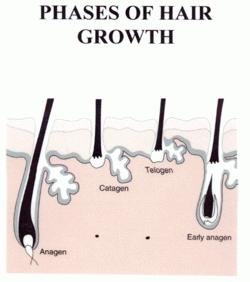 Hair Regeneration
As Both A Research Model For Life-extension And Control Of Ageing And As
A Commercial Therapy.
Hair Regeneration
As Both A Research Model For Life-extension And Control Of Ageing And As
A Commercial Therapy.
In order to advance the more general science of life-extension and control of ageing by biological regeneration, it has been suggested by several people that we select a particular problem which has commercial value and which, at the same time, is directly relevant to solving the more general problem. Probably nothing fits these specifications better than hair regeneration, which was suggested by Vasu.
Attempting to slow, restore, and compensate for hair follicle
ageing (i.e., loss and graying) is obviously a large market, and billions
of dollars are spent annually on palliative measures. It affects both men
and women, with the former experiencing patterned hair loss and the latter
a more general thinning - both experience graying. In addition to appearance,
social viability, and other non-medical considerations, which are the leading
motivators, hair growth and density is a component of immunology and the
general functions of the skin. Any bio-technology that would restore hair
by somatic cell division (i.e., eumitogens) or stem cell differentiation
and proliferation would be directly relevant to the regeneration of bone,
muscle, neurons, and other vital tissues. Indeed, hair follicles have stem
cells (See: Millar
SE. Molecular mechanisms regulating hair follicle development. J Invest
Dermatol 2002; and for an overview select the Related Articles link.)
Therefore, how might we proceed on this prospect in a meaningful and practical
manner. Here is how I would do it.
Step I - Assessment of the state of the science and the design of a strategy. I would construct a proposal for collaboration which would be circulated to investigators in various relevant areas (hair, stem cells, mitosis, etc.) and who can be identified in the MEDLINE database. Obtaining the list is a lot of clerical work, but straight-forward. Some investigators will have e-mails, but most will have to be contacted by postcard. The Internet would be used to coordinate the initial enrollment. The purpose of the collaborative network would be to initially defined and then developed in detail as contact was made and initial feed-back received. A business structure would be designed in advance and potential collaborators would know that participants would be given equities according to eventual contributions. The scientific organization and the business model would have to go hand in hand. This could be a chance for "under-dogs" in the research community to circumvent the usual hierarchy and that would be a motivating factor that could be used to advantage. It would take a good 4-6 months to do this initial organization and assessment of the field and require about $10,000 in seed money. I would envision 5-10 individuals contributing $1-2,000 each to the tax-exempt entity for this first stage of research. Then shares in a limited partnership would be issued if the project proceeds to Stage II. There are three outcomes to this initial study. 1) we might find out that others are already advancing on this line of investigation are well position to commercialize on it, in which case our group can sit back, be ready to become patients for the therapy, and/or invest in the groups that are established. 2) we might discern that this approach is a good prospect for us, and then we proceed to the next stage. Or 3) we discover that the basic science is not sufficient advanced that it can be developed into applications in the near future, in which case we postpone, monitor, and wait. If the first situation is true, that is good to know; if the second situation is the case, then that is an opportunity; and I do not believe the third situation is the case.
Stage II - The design of the research strategy. Let us assume that we evaluate the field, as above, and discern that it is a good prospect for us, that we have established contact with an array of scientists with relevant expertise and who are willing to participate, that we devise a business plan that gives scientists equity and incentive, and that we identify larger companies as potential strategic partners for development once the science is in order. We now must create a research plan and implementation strategy. The best way to do that would be to hold a 1 week seminar this summer at The Claremont, bringing in the scientific team to brain-storm it and resolve who, what, when, where, and how to expedite the necessary research. The cost of this seminar will depend on the numbers of people, and it would be funded by the initial investor group and new investors if necessary. Once the Strategic Plan was done, we then have a real proposal to fund and implement. Then, the initial investors are rolled-over into a corporate structure and implementation capital is developed. There is no way of calculating at this point what that capital might be. I envision a "stealth" research strategy, utilizing the in situ resources of investigators, while covering the out-of-pocket expenses of the scientists but gaining most of their time and expertise as in exchange for equity.